
|
|
 |

|


|
HDTV Buying Guide
Picture Quality Price Screen Type Screen Size Screen Resolution Features Design Accessories November 25, 2009 HDTV Solutions With all of the new TV technologies crowding the marketplace, it's time to update our HDTV Buying Guide. But before I explain some of the new jargon buzzing around showroom floors, like LED TVs, 240Hz frame rates and Internet widgets, I want to lay the foundation so you will have a firm footing when a sales rep begins spouting high tech testimonials about one model or another.  Yahoo Widgets on an LG LH50 When I walk into the television section of a consumer electronics store, I see those blank, befuddled stares. There you are - assaulted by a wall of HDTVs all playing the same program. And for the life of you, all those flat screens look very seductive, but still pretty much the same. How do you decide? Where do you begin? It's easy to become flustered in the presence of this chorus line of sexy, beautiful models with their thin bezels and full HD measurements. If, dazzled by their radiance, you begin to hyperventilate, just picture their parents. The thought of those chunky boxes with knobs sticking out should bring you back to earth. Let's start this Guide with this simple statement. It's a TV. Nowadays, they are bigger and flatter then they were in the 20th Century. They are preceded by HD, but they're still televisions. Whether you grew up watching The Honeymooners or Moonlighting, Bonanza or Buffy the Vampire Slayer, you probably have purchased one or two TVs in your life. Buying this high definition television shouldn't be any different. It's a TV. And despite all the technological mumbo-jumbo, how you decide on what HDTV to buy really isn't any different than it was ten or twenty years ago. All of us want to think that we are making a wise, informed choice and are getting our money's worth, especially in this economy. So let me discuss a few factors that you may wish to consider. High Definition vs. Standard Definition
Before we begin, we need to establish a couple of basic terms. The HD in HDTV stands for high definition. In comparison, those old boxy TVs that we grew up with are standard definition, (SD), though they were never called that because there was no HD. Without be too technical or exact, the picture that we see on a TV screen is made up of thousands of little dots called pixels. SD TVs use fewer pixels to create a picture, which means less detail - or definition - than an HDTV. More definition translates to a sharper, cleaner, finer image - a "honey come look at this" humdinger of a picture. 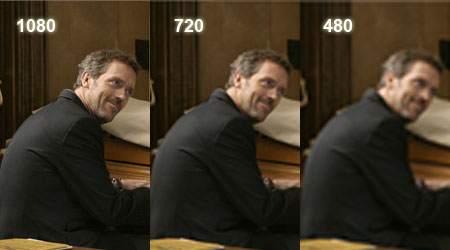 Representation of 1080p, 720p & 480i - More Pixels = Sharper Image Definition for TVs is stated in terms of resolution. When you go shopping, you will probably run across these two common resolution numbers, 720p and 1080p. As you would guess, a 1080p TV uses more pixels than a 720p TV. Both are considered high definition TVs. (For comparison, standard definition is usually stated as 480i or 480p. I don't even want to get into i, interlace, and p, progressive.) I will discuss resolution as a factor in choosing a TV later. At the end of 2009, almost nobody makes standard definition TVs. For example, of the 230 TVs that Best Buy has listed online, only two are SD, the rest are HD. So if you are buying a new model TV, about your only choice is an HDTV. In our original Guide, I predicted that "in a couple of years, we will simply drop the HD tag and go back to calling them TVs." Indeed, we are moving in that direction, though HD still carries significance in a number of topics of consideration. Picture Quality - Minding Your P's & Q's
For me, the foundation for judging any HDTV is picture quality, which cannot be reduced to one characteristic like sharpness or contrast or color. Picture quality is a combination of all those and more. It's the gestalt. When you experience great picture quality, you'll nod your head and think, "Damn, that's what all this hubbub about HDTVs is about." The problem is that picture quality is subjective. For example, I'm particularly sensitive to overly colorful skin tones, so a pleasing picture to me may seem way too desaturated to you.  Toshiba REGZA 47ZV650U In my reviews, I will give you my opinion about a TV's picture quality, but you're the one that has to live with your choice. And the real fly in the ointment is that it is really difficult for you to judge a TV's picture quality by strolling through the HDTV aisles in a big box store - even harder online. If you can, I would suggest that you carry your favorite DVD with you and find a store that you can play it on a few TVs. If nothing else, get your mitts on the remote control and take the TV for a spin around the Setup menu. I know that idea causes dread in the hearts of salesmen; but if you are seriously shopping, then they should be glad to help.  One last thing before we move on. This is a guide. I will not tell you which specific HDTV to buy. There are way too many HDTV models out in the marketplace and I only feel comfortable recommending TVs that I have reviewed. If you want specific suggestions from me, look for the Highly Recommended logo on a review. Price
Let's continue this HDTV Buying Guide with what is often the major consideration in buying an appliance - cost. For most of us mere mortals, we need to decide how much we want to spend. Without some dollar limit, strolling into the HDTV section of the store (whether brick and mortar or online) can lead to a major household budget buster. I'll discuss price of TVs in terms of screen size, screen type, and screen resolution in the following sections. For now, let's talk about cost, near term and long term. Beyond the price of the TV, before you leave the store you will be accosted with a few other expenses that you should factor in - cables, wall mounts, transportation, installation, and warranties. Rather than dive into a long discussion on cables or wall mounts at this point, please see the Accessories section at the end of this article.  Big Box at Your Doorstep If you are buying at the local big box store down the freeway, you will have to transport that lovely toy to your house. And if we're talking about any screen much larger than 32", its box probably won't fit into your Prius. It may not even squeeze into your Escalade. Hopefully, you have a good friend with a strong back and a cargo van. If not, you may want to consider using the store's delivery and installation service. Often installation is priced reasonably and packaged with the TV as an incentive. Do the math, only you can to decide if it is worth it. Of course, if you are purchasing online, then shipping to your door will be calculated into the final price. Unless it is otherwise stated, don't be surprised if the delivery man tells you that there will be an extra charge for maneuvering the box into your TV room or upstairs into the bedroom. Most retailers will try to sell you a warranty that can amount to a sizeable chunk of change. The general consensus is that warranties are not a great idea when it comes to TVs. You can read more about warranties in an article. "What's with Warranties?" Finally, depending on your disposition, when you are buying a big ticket item like an HDTV, negotiation opportunities may arise. With intense competition, the profit margins for retailers on the TVs are fairly thin, but you may find some wiggle room, especially on prices for warranties and installation. Now, once you have your HDTV home safe and sound, you still have one more cost to factor into your budget - HD content. High Definition Content
I almost left this section out of this updated guide because I thought it was much less of an issue than it was two years ago. But just today, I ran across a study that reports that at least 14 million of the 49 million U.S. households that own an HDTV do not receive high-definition programming. I feel so strongly about the importance of supplying your HDTV with high definition programming that I will make this statement. Don't buy an HDTV unless you plan on feeding it high definition content. Stick with your old standard definition TV. Now, this is the important bit. Let me state this simply. Just because you have an HDTV, you don't magically receive high definition content. With that said, here's what you need to do. If you are subscribed to a cable or satellite system, you should contact your provider and make sure that you have all the equipment that you will need from them to receive HD signals. For example, the company might require you to upgrade to a new set top box and you may also have to pay more for an "HD programming tier." Please be aware that many cable companies will provide an SD lineup and an HD lineup of channels. Which can mean that networks like ESPN will broadcast the same game in HD on one channel and SD on another channel. Make sure that you are tuned to the HD channel. You will definitely notice the difference. And that's the whole point. HDTVs look their best when they are displaying HD content. Of course, if you don't hanker to pay for a cable service, you can hook up an antenna and capture a signal off the air like we used to do before cable and satellites - assuming you can get good reception. 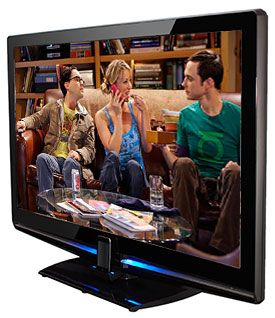 Big Bang Theory on a JVC LT-46P300 Since June of this year, all the full-powered TV stations in the U.S. now broadcast digitally and every new HDTV includes an ATSC tuner that receives the digital signal. Remember that this antenna system only works with broadcast stations, meaning ABC, NBC, CBS, Fox, and the CW. You can't receive any of the cable channels like ESPN or Discovery with an antenna. Once again, receiving a digital signal does not necessarily mean that the program is high definition. But with this over the air method, if a show is HD, then the station will broadcast it in HD. You don't need to worry about tuning into an HD channel. More and more TV programs are being broadcast in HD. For example, nowadays almost all prime time shows like Big Bang Theory, N.C.I.S. or American Idol are being transmitted in HD. Now, if you only want an HDTV for watching DVDs in your home theater, you still should be feeding it HD content. If you have a library of SD DVDs, then at least purchase a DVD player that processes the standard definition signal and converts it to HD. Though this upscaling feature is a bit of video hocus pocus and can never achieve the same picture quality as true HD content. The best source for HD movies are Blu-ray DVDs which can only be played on Blu-ray players. The prices of Blu-ray players are dropping down to OMG, it's about time! levels. If you are in the market, you can find our Blu-ray Player Buying Guide here.  OPPO's BDP-83 Earned Our Highly Recommended Rating Once again, if you are not going to make the commitment to provide HD programming, I would seriously suggest not buying an HDTV. But if you are ready to take the leap, let's move on to the more commonly discussed factors. LCD vs. Plasma vs. Microdisplay
Almost all of the HDTVs available right now fall under one of these three categories of displays. (If you are looking for a technical explanation of each, you're reading the wrong article.) If your only concern is to buy a TV that will display a great looking HD image, the best models in all three categories will deliver the goods. So, you may be asking, "Why care about LCD, Plasma, or Microdisplay?" Well, if you ask the proponents of one or another, they will wax eloquent and occasionally belligerently about the superior qualities of their favorite. Many of the advantages that one display had over another has narrowed in the past couple of years. Let's start with a simple point that shows how the designers are aware of a shortcoming, make the necessary change and in the process improve their product. Take Microdisplays, which used to be called RPTVs (rear projection TVs), because they have a projector system inside them.  Mitsubishi's LaserVue TV The problem used to be that the projector light bulb would burn out every two or three years depending on how much TV you watched. Not a big issue for some people, but a drawback. Many newer Microdisplays now employ lighting technologies that negate the need for replacing the bulb. Mitsubishi even features a TV that uses a laser as its light source. The real heated debates are over the perceived advantages of either Plasmas or LCDs. Especially in this arena, I have seen the differences dissipate. For example, Plasmas historically had a better Contrast Ratio than LCDs. Contrast Ratio is simply a measurement that indicates a TV's ability to display the range of darks to lights. The theory is that the higher the Contrast Ratio, the deeper the blacks, the whiter the whites, the better the picture quality. A couple of years ago, Plasmas were kings with Contrast Ratios near 10,000:1. Now, you can find both top of the line Plasmas and LCDs spiraling up over 3,000,000:1. Yes, three million. 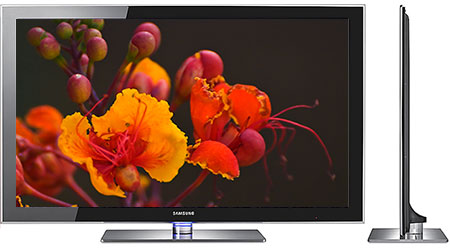 Samsung PN50B860 Plasma with 3,000,000:1 Mega Contrast When we reach this range, only Superman could see the difference. And I don't want to confuse you with numbers. My point is that a lot of the old advantages of LCDs or Plasmas are fading away. And I don't think you can judge by numbers which TV you want to buy anyway. Often your choice boils down to a much more subjective factor. For example, Plasma screens have a reputation for being more reflective than LCDs. This can cause some folks great anxiety especially if they see their table lamp reflecting in their brand new HDTV. Also it can be a problem during the daytime if your TV is in a room with a lot of windows. Personally, I don't notice reflections, especially when the TV is turned on. Also, if they did bother me, I would turn off the light and close the curtains. But like most competitive disadvantages, manufacturers are addressing the situation and producing less reflective coatings for Plasmas.  Sony BRAVIA KDL-40XBR9 LCD As I was researching this Buying Guide, different camps would point to Color Gamut charts or Refresh Rates to show that they were king of the hill. I always believe that the best test is what you see on the screen. (I mean that in an abstract sense. Please do not judge a TV by the overly vivid displays that assail you at your local big box store.) If you ask me, I lean towards Plasmas because I think I can perceive a better picture because of deeper blacks. But I have seen plenty of good looking LCDs that I would be proud to own. Sales figures in the U.S. show that LCDs are now outselling Plasmas with Microdisplays a distant third. Coming up, I will discuss some of the other characteristics that may give one an edge over the others. LED TVs
In the last two years, the biggest technological wave to sweep over the TV market has been dubbed LED TVs. Almost every major manufacturer has released at least one LED TV model. The term is a bit misleading because all LED TVs are really at their core LCDs. In the past, LCD TVs typically employed CCFL (cold cathode fluorescent lamps) as backlights. Recently, designers have begun to replace the CCFLs with LEDs (light emitting diodes). Therefore, perhaps more correctly, LED TVs should be called LCD TVs with LED backlights. This LED wave is about to become a tsunami. DisplaySearch forecasts that by the end of this year, about a quarter of the new LCD TVs will have LED backlights, with that percentage doubling by 2011. What does this trend mean to you? LEDs are more energy efficient making LED TVs some of the least power hungry models available. For example, I reviewed the Sharp LC-40E700UN LED backlit TV and remarkably this 40" LCD consumes the same amount of electricity as a 75W bulb. For comparison, you can find Energy Star rated LCDs that use twice that much.  The Power Sipping Sharp AQUOS LC-40LE700UN LED Backlit TV I'm a big proponent of energy efficient TVs and LED TVs are definitely leading the pack. But what also excites me about LED backlights is their capability to perform a neat trick called local dimming. TV designers are placing the LEDs in two different locations. One method is to position the LEDs around the outer edge of the LCD screen, often called side light or edge-lit. The second method places an array of LEDs behind the LCD panel, often termed direct. The advantage of this direct orientation is that it allows local dimming. The exact number of LEDs in these direct backlight arrays used to be a closely guarded corporate secret. Though now VIZIO touts in their TV ad that their VF551XVT 55" TruLED LCD contains 960 backlighting LEDs. 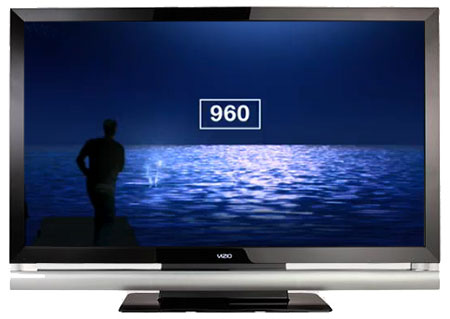 The VIZIO VF551XVT with 960 LED Backlights Imagine 960 little lights behind your TV screen. With local dimming, if you are watching a movie and part of the scene is in shadows, then the TV lowers the brightness of the backlights in that area accordingly. If part of the image is in deep shadow or totally black, the dimming will reinforce the darkness. Basically, the TV can produce darker darks, which makes colors seem richer. Does it rival plasmas in this aspect? It's becoming a horse race, though I still believe plasmas are still out front. What I can say is, from what I have witnessed, LED backlit LCD TVs with local dimming produce better picture quality than their non-dimming LCD counterparts. To be clear, not all LED backlit LCDs feature local dimming. And of course, local dimming LED TVs are also more expensive - actually these models are often the costliest LCDs that a company makes. Is the bump up in picture quality worth it? That's a decision that you, your loved ones and your wallet will have to make. As always, if you can wait until this cutting edge technology becomes more mainstream, the cost premium will become almost nonexistent. Before we leave this topic, let's clear up one more distinction. In the TV display world, LEDs (light emitting diodes) and OLEDs (organic LEDs) are two distinct animals. OLED TVs have tickled videophiles' fancies for almost two years because of their promise of super thin screens displaying super duper images. But producing a large size OLED TV that is not super pricey has proven super hard. In late 2009, the only OLED model for sale in the U.S. remains the Sony XEL-1 and it measures just 11" diagonally, costs $2500 and it's not HD. LG recently released a 15" 720p OLED TV in Korea. And I assume that at CES in January we will see OLED pre-production models ranging in size from 20" to 40" from most of the major players like Sony, Samsung and Panasonic. 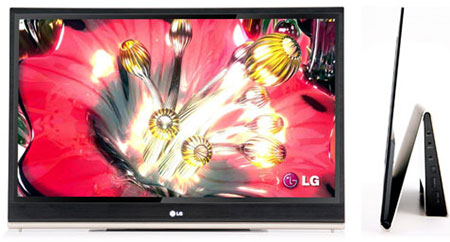 LG's 15-inch OLED I still think it will be 2011 or 2012 until OLEDs can exert any impact on the HDTV marketplace. Size
Undeniably, screen size matters when buying an HDTV. But how big of TV do you need? How far away from the TV do you plan to sit? Five feet? Ten feet? If it's around 5', then the THX folks suggest a 50" TV. Then again, the SMPTE (Society of Motion Pictures and Television Engineers) guideline says that a 37" TV would work. (I cover viewing distances in much more detail in my article, "Pull Up a Chair".) If you're familiar with the old rules of sitting three or four times screen width away, then even the SMPTE suggestion may seem close, but remember we're talking about high definition images that can withstand close inspection. One of the reasons that Microdisplays gained prominence in the marketplace and still can be a viable niche is their size to price advantage. Though the gap is closing under 50", Microdisplays still are a good value alternative if you want an HDTV in the over 55" range. Mitsubishi even makes an 82" model, the WD-82837.  The 3D-Ready Mitsubishi WD-82837 Microdisplay (Front & Side) Older models had some picture quality issues, but many of the top of the line Microdisplays hold up surprisingly well next to LCDs and Plasmas. The other slam against Microdisplays is that they are deeper than their HD brethren. Indeed, even now after they have slimmed down quite a bit, Microdisplays lose the battle of the bulge when compared the diet conscious LCDs and Plasmas, which average around 3 to 4", with the skinniest barely topping an inch. But despite their girth, Microdisplays are lighter than they look, a little over 70 pounds for a 65" screen compared to almost 133 pounds for a 63" Plasma. Finally - and this can be a deal breaker - Microdisplays are not made to be mounted on a wall, unless you customize a shelf. Traditionally, if you wanted a TV over 40", Plasmas were the display of choice. In the last couple of years, new production facilities have started to churn out larger LCD panels, with 46" LCDs now a common size. We are even seeing 55" LCDs at under $3000 MSRP. Prices in the marketplace constantly gyrate, but Plasmas have been consistently less expensive than a comparatively sized LCD, especially in the 46" and over range. And if you want a TV that is 60" or larger, you will find a precious few LCDs, though they are beginning to pop up. If you desire to be the biggest boy on the block, Panasonic does sell its 103" TH-103PF10UK Plasma for a paltry $50,000.  For a Really Big Screen - 3 Panasonic 103" TVs Side by Side The playing field below 40" has been ceded to LCDs, which is one of the reasons they have gained a sizable market share. One trend that I track is what I call the sweet spot for HDTVs. As TVs become larger, they are incrementally more expensive. At some size, the price jumps more than usual. The size right below that is the sweet spot. Late in 2009, that spot is a moving target because manufacturers are offering models with different features that cover a range of price points. For example, LG markets nine 42" LCDs starting at $850 MSRP and going up to $2000. Let's face it, not everybody wants a large TV dominating their room. One solution is what I call a hybrid HDTV that also can double as a computer monitor, which is perfect for a bedroom, dorm room, or kitchen. I'm beginning to see a lot of 1080p hybrid LCDs in the 24" range. And remember when a 32" TV was considered humongous? Now, it seems like a mid-sized compact. With street prices for even brand name models below $500, many folks are finding this size a good fit. 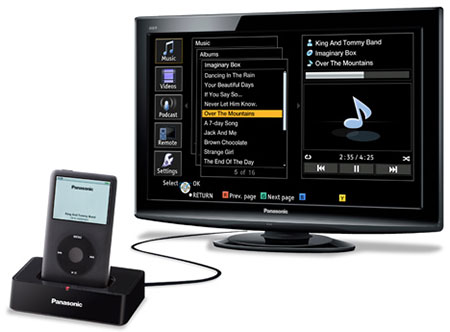 The Panasonic Viera TC-L32X1 32-inch LCD with iPod Dock Resolution - 1080p or 720p?
I tend to push Resolution down my list of factors for buying an HDTV because I think other characteristics are more important to my viewing satisfaction. For example, I would prefer a 720p TV that rendered skin tones well over a 1080p one that made everyone look as if they had high blood pressure. Of course, all other features being equal, I'll take the 1080p. Even though it may seem that every new TV is a 1080p, there are still plenty of very good 720p models being made and I find that they are often very competitively priced. If a salesperson is working on commission don't be surprised if he denigrates a 720p model while steering you towards a 1080p TV. The big advantage of 1080p displays is all those extra pixels, which make for a sharper, more detailed image. Of course, if you are sitting too far away from the TV, your eyes will not be able to discern the difference between a 1080p image and a 720p. For a 50" TV, that distance is about 6.5'. (Again, I write about this in the "Pull Up a Chair" article.) 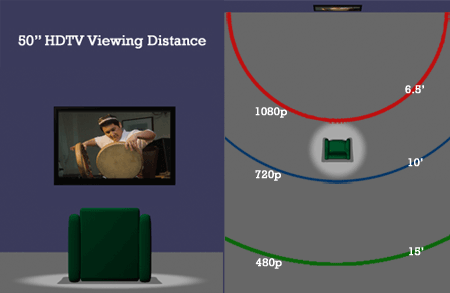 Viewing Distance Chart So don't shy away from a 720p TV especially if you are planning to sit a moderate distance away. In fact, some of my favorite TVs have been 720p Plasmas, which have exhibited almost three dimensional images because of their great contrast and black levels. You also may be able to find some seriously tantalizing values in 720p TVs as the focus has shifted to 1080p models. As a teaser for the next time I update this guide, manufacturers are already discussing Ultra HD TVs with a resolution four times greater than 1080p.  Features
Features come in many flavors. Depending on your tastes you will probably focus in on one or two of your must-haves. For some, it may be as simple as a remote control that lights up. For others, it may be more technical like a 240Hz frame rate. I will admit that when it comes to the proliferation of features, life used to be much simpler. But those less complicated TVs provide a good benchmark for your new purchase. If you are a traditionalist who just wants a TV to watch sports and your favorite prime time programs, then a lot of the new buzzword features shouldn't be that important to you. Luckily, a number of manufacturers have heeded your pleas and are producing no frills TVs that are also less expensive. Now if you are a feature junkie, you'll know that last year's must-have was an LCD with a 120Hz frame rate. That fad was so 2008 and it was quickly replaced with 240Hz displays. I explain frame rates in detail in my review of the 240Hz VIZIO SV471XVT. Please read it if you need a refresher.  Interpolating Frames to Go from 60 to 120HZ When implemented well, these higher frame rates will smooth out fast moving action. I have witnessed video torture tests that cause the image to stutter or judder (imagine tiny text scrolling quickly across the TV screen), and yes, 120Hz and 240Hz features do improve the image. Though, from my day to day viewing experience, I'm not bothered by this stuttering. If I am paying a premium for a 120Hz or 240Hz TV, I will look elsewhere to spend my money. Also, 120 and 240 frame capabilities are a feature of LCDs. Plasma technology works differently, so there are no 120Hz or 240Hz Plasmas. Actually to counteract the Hz marketing hype, plasma manufacturers rolled out the term, 600Hz Sub-field Drive. I queried a representative of one of these companies to clarify what 600Hz indicated. Basically, the plasma is showing you sixty frames a minute, but it is flashing each frame ten times. I realize that explanations like this can make you dizzy. I'm feeling a bit queazy myself. The bottom line is that you have to look past these terms and gaze intently at the image on the TV. Of course, purchasing an HDTV allows you to expand your horizons and I have found that a couple of new features have ascended to the top of my list. If you want to connect directly to your home network, many TVs now offer an Ethernet port. The ability to access media assets, like photos or music files located on your computer or a server is compelling for many wonks. Even more important for many who have grown up suckling on the web, is a TV's ability to connect directly to the Internet. Of course, you could always hook your TV up to your computer and use it as a monitor. But what is becoming much more prevalent are TVs that can interface directly with web content without a computer as an intermediary. Often that interface is in the form of widgets. Basically, widgets are little icons that you can overlay on your TV screen. Each icon is a link to information accessed from the Internet. For example, many TVs offer Yahoo widgets for news, weather and financial data.  Widget Gallery on the Sony Bravia KDL-40XBR9 In some cases, you can customize the information the tickers provide, like having the weather widget show the temperature in your town. Personally, I am not a big fan of widgets cluttering up my TV screen. But I can see how they can provide instant information, and they can simply be toggled on and off with a click of a button. What is more appealing to me are the partnerships that TV makers have formed with Internet content providers like YouTube and Amazon, which allow you to stream on-demand entertainment directly to your Internet connected TV. I especially like the ability to stream movies directly to my TV through services like Netflix or Amazon Video on Demand. Before you get too excited about the possibilities, let me mention a few caveats. First, you need to connect your TV to the Internet, which may be a logistical nightmare if your router is in another room and you have to run a Cat 5 network cable down the hallway. Second, for many TVs, the remote control is your data entry device. If you are searching for a title on YouTube, you'll quickly wish that you had a keyboard. Next, and this will become more and more important as a wider range of high definition content becomes available, if you are serious about obtaining good picture quality from streaming video sites, you will need fairly fast and robust bandwidth from your Internet provider, ideally over 10Mbps. I believe that with sufficient bandwidth, streaming services will become the way many of us will be acquiring video programming in the future. Also, not all TVs offer the same Internet content providers. If you have a favorite, check to see if the manufacturer has partnered with them. 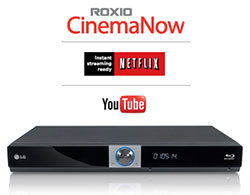 LG BD370 & Its Internet Partners Finally, most of these streaming services are available through other equipment like Blu-ray players. It may be cheaper to buy a Blu-ray player than to upgrade your TV purchase. If a TV doesn't connect into a home network, the next best option is a TV with a USB port or SD card slot. It allows you to attach a flash drive, (like the kind that comes in digital cameras), and access photos, music or video files. Viewing photos in high definition splendor is highly rewarding. I'm the guy in the TV section who is always peeking behind the equipment to see what extras the connection panel offers. Luckily, most TVs now provide an adequate number of audio and video inputs. I know others lust after picture-in-picture capabilities. I'm not a big fan, but if I need PIP, my satellite's set-top box has that feature. And then, some features are more difficult to ferret out. For example, I find a well written manual to be invaluable. If you want to browse before you buy, often you can locate manuals online at the manufacturer's website. Since I need to tinker with picture settings, a well organized Setup Menu with responsive tools is manna from heaven. If you love to tweak, root through the manual and see what controls are provided. Before we leave our Feature list, let me mention 3D-ready TVs, which are capable of playing back 3D content like you experience in movie theaters. Manufacturers like Mitsubishi and Samsung have produced 3D-ready TVs for a couple of years, the problem has been a delivery system.  Panasonic's 3D Traveling Roadshow With other like Sony and Panasonic committed to pushing 3D, I think we will hear plenty of trumpeting in 2010 and may even see a 3D-ready Blu-ray player. You can read more details about 3D in my CEDIA 2009 report. Brand
If you are a loyalist, all you need to do is see your favorite logo stamped on the TV. Shopping is done, life is simple. I won't discount this method of choosing a TV, especially when Brand allegiance is based on a history of consistent quality and great customer service - not just nostalgia. Of course, in this corporate climate of mergers and acquisitions, Brand names have a tendency to disconnect from their historical roots. Also, you may miss out on a newcomer that offers quality products at a competitive price. Design
I appreciate that these flat screen TVs are so much more appealing than the old bulbous TVs that demand you hide them in an armoire. The elegant sleekness of HDTVs has been warmly welcomed into many households. Still, I feel like we are back in the Model T era when Henry Ford proclaimed that "The customer can have any color he wants so long as it's black." We are seeing very few divergences from this black motif and usually they are very subtle like Samsung's Touch of Color models. Those aside, the choice remains, matte black or glossy piano black.  The 1.2-inch Deep, Touch of Color Samsung UN46B6000 LED TV Designers seem to be spending most of their efforts figuring out how to flatten TVs thinner than a flapjack. Many higher end models like the LG 42SL90 are slimming to almost an inch thin, which is about the width of two fingers. Of course, if you don't plan on wall mounting, the TV's stand will add a few more inches to the profile. Also, if you are planning to squeeze the TV into a niche or that armoire, you can find dimensions in our HDTV database, which I discuss below. Accessories
 Bang & Olufsen BeoVision 7 Audio
I consider good audio to be a vital part of the TV viewing experience. I truly believe that a great audio system makes a home theater. Hallelujah! With that said, I have reviewed very few HDTVs that provide a worthy integrated sound system, even for normal TV watching. I have only encountered a couple of TVs that included audio that could be rated home theater quality. I suggest that if you are upgrading to an HDTV, think about acquiring a dedicated audio system, which includes an AV receiver and a 5.1 or 7.1 surround speaker setup. If you are buying a new AV receiver, look for one that can accommodate and switch between multiple HDMI inputs. If you are not ready to commit to a full fledged, speakers-in-every-nook-and-cranny, sound system, then consider a middle ground solution called a sound bar. I have reviewed a number of them and they produce highly listenable results in compact packages. 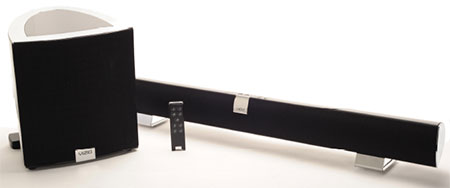 The VIZIO VSB210WS Sound Bar with Wireless Subwoofer Some sound bars like the ZVOX Z-Base 550,you can place under the TV. Others like the VIZIO VSB210WS include a separate subwoofer. Cables
If you plan to attach your TV to other pieces of equipment like the cable company's set-top box, a DVD player or an AV receiver, you will need cables. Please be forewarned. You cannot use the Composite video connections to transport your HD signal. On your TV, you must either attach to an HDMI input or the three Component (often labeled YpbPr) inputs. You have a choice. I would suggest that you use HDMI cables because they carry both the audio and video signals. One connection, one wire, less clutter. Now if your DVD player or set-top box does not have an HDMI output, then you will need Component cables. To connect the video, you use a three headed cable with Red, Green, and Blue ends. Audio requires another cable with Red and white ends. 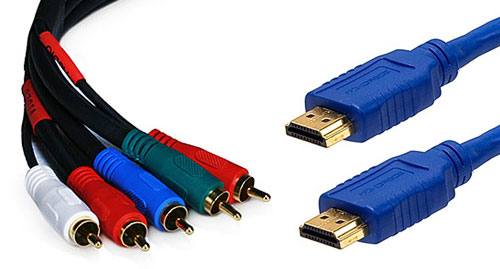 Component & HDMI Cables from Monoprice The price range for HDMI cables is eye opening. I've seen 6' HDMI cables sell from $5 to $70. If you are not a discerning videophile, consider the more reasonably priced ones. If you think you have an eagle eye, then buy both and test if you can see a difference. Wall Mounts
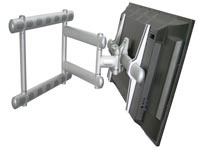 Premier Mounts' Swingout Arm When you see those ads of carefree young couples lounging around watching their HDTV mounted on the wall of their minimalist loft, you think what could be simpler than hanging a TV on a wall? Nothing - if you hire a guy to come in and snake all those video and audio cables inside the sheetrock. Wall mounts are fairly reasonably priced, the actual installation can be another matter. If you can't be talked out of placing your TV above the mantelpiece, please buy an articulating mount so you can tilt the TV down to where you are sitting. How to Use Our HDTV Database
We spend considerable time and effort maintaining an up to date database of HDTVs, which you should find valuable in researching your TV purchase. If you look at the navigation list on the left of this web page, under Research are three different ways to access our database: Search by Brand, Search by Model, and Search by Features. The mother lode of data resides in the specification sheets for individual models like this one for the Sony BRAVIA KDL-40VE5. The tabs on that page often provide more information. And you can compare different TVs by clicking on the "+ Add to Compare" feature. Happy hunting. If you have other shopping tips, please add your comments below. 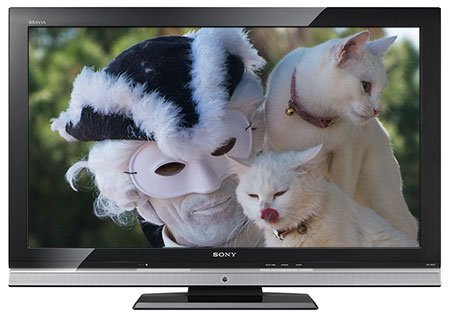 Sony VE5 Eco Series 40-inch LCD |
Bookmark:
![]() del.icio.us
del.icio.us
![]() Reddit
Reddit
![]() Google
Google
Reader Comments
| Send this Page | Print this Page | Report Errors |


Posted Dec 23, 2009 9:58:44 AM
By Jay Soto
Thank you for being as much of a one stop info gathering spot that reads in normal language. Hate those sites that use all the tech lingo knowing that the majority of people don't understand but great for the junkies I guess. Now if you can only go shopping, pay and install the equipment for me and for free, this would be the best site of all time.
Thanks, J